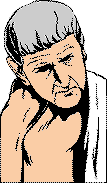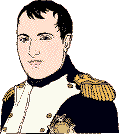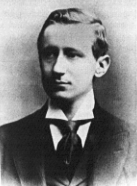
 |
A discussion of the earliest forms of sending messages over great distances: runners (where does the marathon come from?), horse relays (before the Pony express!), homing pigeons, smoke signals (Polybius' alphabetic code), torch signaling, heliographs (flashing mirrors), signal flags (especially in the Navy). Recurring themes: methods for efficiently coding information, ways to insure the secrecy of information being transmitted, what it takes to construct infrastructures that span a region, how to synchronize senders and receivers, the separation of control messages from data message. |
 |
Encoding of common messages and characters in symbolic form. Cryptography and secret writing. "Telegraph: writing at a distance." Information traveling faster than the quickest form of transportation. Development of the optical telegraph (aka "wig wag") in the late 18th Century. Deployment of the first optical telegraph SYSTEM in France and its use in the French Revolution and the Napoleanic wars. 5000 km and 556 stations by mid-1800s. First recorded use of error control (resend a lost character), flow control (send faster, send slower), and message priority. Alternative systems, such as the octal encoded shutter systems of England and Sweden. |
Engineer/Entrepreneur: Experiment: |
|
Electromagnetism discoveries (e.g., Cooke and Wheatstone) leading up to Samuel F. B. Morse's invention of the Morse Code and his system for its transmission in 1844. First U.S. government funded demonstration: Morse's system between Baltimore and Washington. Telegraphy and its relationship to the railroads. The inventor as an entrepreneur and how the telegraph infrastructure was financed and deployed in US and elsewhere. The development of submarine telegraph cables and the great adventure to span the Atlantic in 1850s and 60s, and then the world. Lord Kelvin's contributions to long distance, submarine telegraph technology. The nationally sponsored telegraphic cartels. Communications as a driver of imperialism and international politics: the desire for the "all red" route.
- The Media History Project Connections Page on Telegraphy
- National Inventors Hall of Fame: Samuel F. B. Morse
- MIT's Invention Dimension: Samuel F. B. Morse
- Michael Faraday and James Clerk Maxwell
- N. Stephenson, "The Hacker Tourist: Fiber Link Around the Globe (FLAG)," Wired Magazine, (December 1996), pp. 97-160.
Political context: how to circumvent the existing national monopolies for telegraphic lines. Technology build up to Marconi's invention: Maxwell's electromagnetic waves and Hertz's oscillators. Marconi's early experiments with spark gap transmitters and coherer receivers in 1895. Marconi as the Bill Gates of his age: inventor, promoter, and businessman. Marconi spans the Atlantic in 1901 with long wave transmission and the discovery of the Ionosphere. Marconi's Wireless Monopoly. International treaties to deal with the issues of spectrum allocation and managment across national boundaries.
Inventor/Scientist/Entrepreneur: Possible Field Trips: |
|
 |
Alexander Graham Bell demonstrates early telephone system during 1876 Centennial Exposition. Building out the telephone network with switches and twisted copper wires. Manual pegboards to mechanical and later electronic switches. Multiple conversations on the same set of wires. FCC formed in 1934. Mobile radio through to the cellular telephone system that exists today: police dispatch radio, mobile telephones, cellular phones.
Fleming and DeForest, and the invention of the vacuum tube. Voice as well as dots and dashes. Sarnoff's role in the Titantic disaster. First transcontinental voice communication in 1915 via shortwave. Formation of the Radio Corporation of America to circumvent Marconi's monopoly after WW I. Introduction of broadcast radio in the 1920s. Early development of television. First "personality" broadcast on television: Felix the Cat. AM versus FM radio. Edwin Armstrong and the independent inventor versus Corporate America.
Engineer/Entrepreneur: Possible Field Trips: |
|
|
Circuit vs. packet switching. Early days of the ARPAnet. Development of routing protocols (TCP/IP) and network services like naming. ARPAnet becomes the Internet, driven by the needs to integrate packet radio, satellite networks, and the ARPAnet. Aloha Net and its influence on the development of ethernet. Packet radio technology. Government decision to privatize the Internet in the early 1990s. Key players include Paul Baran, Robert Taylor, Larry Roberts, Frank Heart, Dave Walden, John McQuilan, Bob Kahn, Vint Cerf, etc. The important role of Berkeley Unix in the development of the Internet. Metricom service available on campus today.
- Internet 25th Anniversary
- B. Leiner, et. al, "The Past and Future History of the Internet," Communications of the ACM, V 40, N 2, (February 1997), pp. 102-108.
- J. Adam, "Geek Gods," The Washingtonian, (November 1996), pp. 67-113.
The history of international agreements related to mail carrage across borders. The need for standardization and international treaties to interconnect national telegraphic systems at national borders. International treaty developments to avoid radio interference. Regulatory environment in the United States: FCC and the deregulation of the phone company. Convergence among data networking, telephony, television services.
- Brief History of Networking
- Chis Thompson, "I was a Radio Pirate," East Bay Express, 31 January 1997
- Louis Uchitelle, "What Has the Computer Done for Us Lately?," NYTimes, Sunday, 8 December 1996, page K-1.
- Lawrence Zuckerman, "Do Computers Lift Productivity? It's Unclear, but Business is Sold," NY Times, Thursday, 2 January 1997, page C-15.
| Engineer/Entrepreneur: Bob Kahn, Vint Cerf |
|